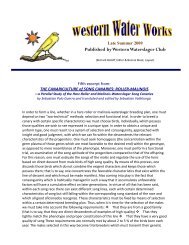Newsletter 1-06.pdf - Western Waterslager Club
Newsletter 1-06.pdf - Western Waterslager Club
Newsletter 1-06.pdf - Western Waterslager Club
You also want an ePaper? Increase the reach of your titles
YUMPU automatically turns print PDFs into web optimized ePapers that Google loves.
for a significant statistical study), but only a few are produced, we could have insteadgotten in truth a singer that perfectly sang the phrases of the stock of the grandmotherinstead. Therefore we would have had the re-emergence of recessive homozygouscharacteristics (like the recessive genes of the color canaries, when two carriers arepaired).If a breeder succeeded in establishing in his stock two distinct lines that behave asdominant and recessive one regarding the other, it could be truly looked at as the dawnof an unimagined world: the application of scientific criteria not on single pairings, but onpopulations. The creation of a feminine line, if it came to a good conclusion, woulddetermine the outcome of breeding with a constant expression, as I will try to exemplifyat the end of this note. First I would like to specify that, the way I see it, dominant andrecessive factors have, above all, a value relative to the single pairing and can giveexcellent results only with those canaries that are very well know to the breeder. In otherwords, if some year we have the fortune to see a champion born in our breeding room(these are things that can happen, it is enough to note the fact!), it is useless for us to runto Zurlo to ask him for five recessive females to breed with him: I don’t believe that wewould end up having many photocopies of the father-champion! The dominant line andthe recessive line can be seen only in the lens of a single pairing; they are a way to operateselectively that aims at the constant production of show subjects.I would like to conclude by examining the practical implications of what I have written, inorder to render more clearly my thought, and to confirm that I have understood theZurlo’s article. I will do this by answering this question: is it worthwhile to raising canariestaking account of the dominant and recessive characteristics, to the point of constructing afemale line?It depends on the breeder! For one who, as I, has little experience, an ear that is not toodiscerning, few pairs, little space, and little time, probably not: it is easier to limit himselfto the traditional methods, to gain experience, to try to become rich culturally, and toplease themselves with the joy of openness, of the not so lofty song of his own stock andthose small improvements that the canaries succeed in making year after year; for resultsof prestige the time is not yet ripe (and I am not in a hurry...).Very different is the discourse of the great breeder, great not only for the number ofpairs raised or goals met, but also great in the passion, the sensibility, the intuition, theability to make choices and in the temerity to still experiment, even when the bestpossible results seem to have been achieved. A breeder of this sort knows his canaries likethe contents of his pockets and chooses the subjects for his pairs with a sure hand. He thatcan construct, as in breeding the mosaic canary, a male line and a female one, that we willcall recessive, because he knows which in his canaries are the modalities of transmissionof the individual song phrases, which behave as recessive and which as dominant. Butwhile the mosaic canary breeder operating in this way produces subjects to exhibit at ashow, the breeder of Malinois obtains the breeding birds to pair: male-dominant line Xfemale-recessive line, already sure of the result, that is, canaries with a paternal stamp, butwith a little something more given from this heterozygous breeding program (and notaccidentally, as we do when we mix subjects of various stocks!). The subjects obtainedfrom this pairing are those destined for the shows.



